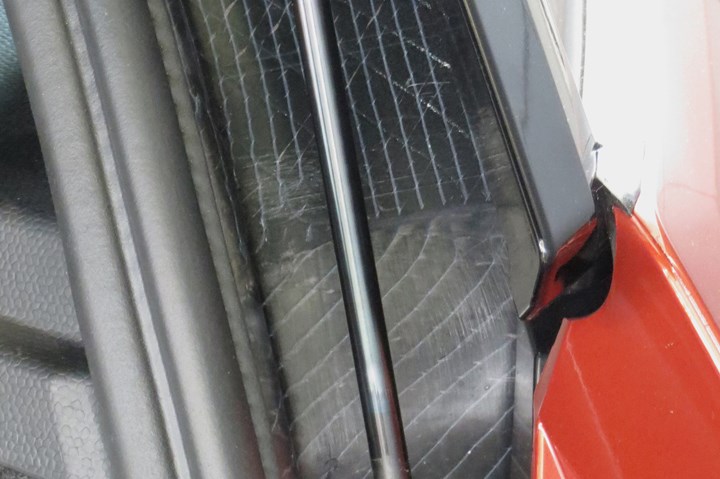From the CW Archives: Fast-cure epoxies for automotive fabrication
Sara Black’s 2015 report on the development of snap-cure epoxies for automotive manufacturing still resonates today.
I took this photo of the frame of the BMW i3 EV at the Composites Europe trade show in 2013. This was among the first events at which BMW showed the vehicle. The company’s innovative use of carbon fiber is visible here in the weave along the tailgate frame. The i3, at the time, seemed to herald a paradigm shift in automotive composites use. Resin suppliers responded by developing snap-cure epoxies to meet the needs of the high-rate automotive industry. Photo Credit: CW
Composite materials have enjoyed strong penetration into several end markets and applications, like aerospace, defense, wind energy, marine, and high-performance automotive.
High-volume automotive, however, has been a challenge. For a very long time — starting in the early 1990s and into the early 2000s — there was an established belief throughout the composites industry that if the price of carbon fiber could be reduced to $5/pound, then automotive OEMs the world over would finally clear the carbon fiber value hurdle and apply it to new cars and trucks in volumes unlike anything the composites industry has ever seen.
There is much hyperbole in this belief, which I explored in one of my editorials in 2017: “Autocomposites and the myth of $5/lb carbon fiber.” But that’s not really the subject of this edition of From the Archives. I want to revisit the other half of what became the automotive composites conundrum: Cycle time.
Composites manufacturing, as many of you know, grew up serving markets that were immune to the long cycle times composites manufacturing typically offered. The use of hand layup, vacuum bagging, debulking cycles, complex infusion regimes and long autoclave cure cycles were suitable for aerospace, marine and wind blade fabrication.
But in the JIT automotive supply chain, where cars are produced at rates measured in the hundreds of thousands per year, and where margins are razor thin, a manufacturing process measured in hours just doesn’t cut it. In short, it doesn’t matter how much the carbon fiber costs if you can’t use it to produce an automotive part quickly and cost-effectively.
Around 2012, BMW decided to apply carbon fiber to the passenger cell and body panels of its forthcoming BMW i3 and i8 EVs. The company eventually built a full carbon fiber supply chain — precursor, fiber plant, weaving, structures frabrication — to produce these parts. The composites industry, seeing this and sensing a possible paradigm shift in carbon fiber’s favor, responded.
One of the most notable responses was the development, by many of the industry’s larger epoxy manufacturers, of snap-cure epoxy resin systems, targeted specifically toward automotive applications. The goal was a simple but daunting one: 60-second cure.
CW’s Sara Black, in 2015, wrote a definitive guide to resin systems that were brought to market by the likes of Dow, Westlake Epoxy (Hexion at the time), Syensqo (Cytec at the time), Huntsman, Toray, Hexcel and others. Her report is here: “Automotive composites: Thermosets for the fast zone”
This was, arguably, the first concerted, widespread effort by the composites industry supply chain to produce a single material type for high-volume automotive manufacturing. The question, of course, is this: Did it work?
Yes and no. It turns out that BMW’s bold leap with the i3 and the i8 was temporary. The carbon fiber supply chain BMW built has, for the most part, been dismantled, and both cars are out of production. But BMW is still among the leaders when it comes to application of composites in automotive structures. And the vast majority of the resin systems Sara reported on nine years ago are still on the market, and many of them are being used today to manufacture automotive parts and structures.
Related Content
Thermoplastic composites welding advances for more sustainable airframes
Multiple demonstrators help various welding technologies approach TRL 6 in the quest for lighter weight, lower cost.
Read MoreCarbon fiber in pressure vessels for hydrogen
The emerging H2 economy drives tank development for aircraft, ships and gas transport.
Read MoreRecycling end-of-life composite parts: New methods, markets
From infrastructure solutions to consumer products, Polish recycler Anmet and Netherlands-based researchers are developing new methods for repurposing wind turbine blades and other composite parts.
Read MoreComposite rebar for future infrastructure
GFRP eliminates risk of corrosion and increases durability fourfold for reinforced concrete that meets future demands as traffic, urbanization and extreme weather increase.
Read MoreRead Next
CW’s 2024 Top Shops survey offers new approach to benchmarking
Respondents that complete the survey by April 30, 2024, have the chance to be recognized as an honoree.
Read MoreFrom the CW Archives: The tale of the thermoplastic cryotank
In 2006, guest columnist Bob Hartunian related the story of his efforts two decades prior, while at McDonnell Douglas, to develop a thermoplastic composite crytank for hydrogen storage. He learned a lot of lessons.
Read MoreComposites end markets: Energy (2024)
Composites are used widely in oil/gas, wind and other renewable energy applications. Despite market challenges, growth potential and innovation for composites continue.
Read More



























